Family : Octopodidae

Text © Dr Domenico Pacifici

English translation by Mario Beltramini
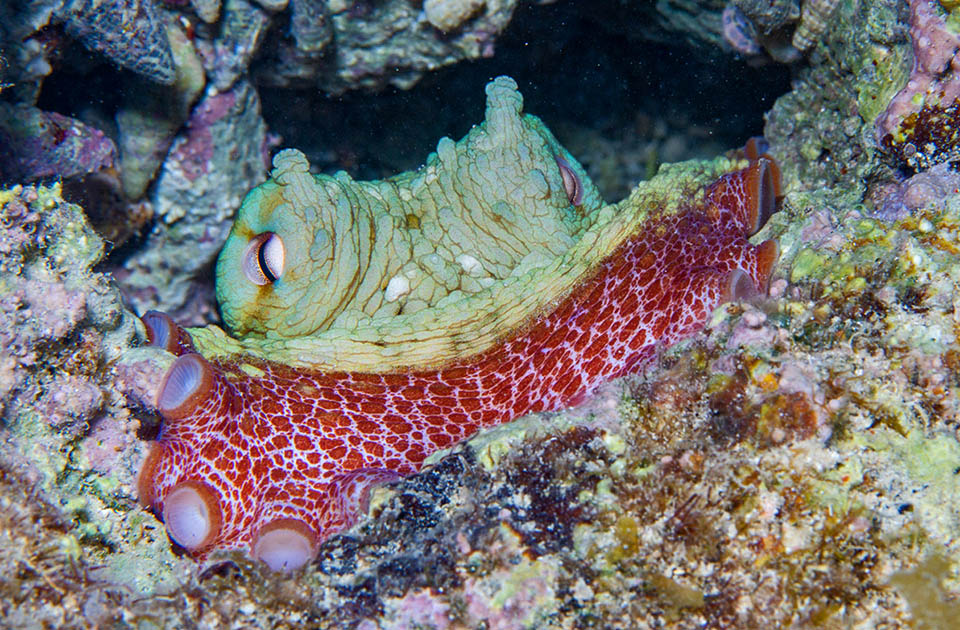
A Common octopus (Octopus vulgaris) with sense of humour, while observes mimicked from the den the Caribbean waters © Allison & Carlos Estape
From the dawn of times the human mind has fantasized about sea animals of incredible dimensions, unstoppable predators and monstrous beings guarding a still obscure world full of resources, that has always fascinated and terrified the man. Therefore, it is not easy to talk about the octopus without having our minds going to children’ books or sea movies, where a huge animal named Kraken attacks and destroys sailing vessels and boats, swallowing eagerly the whole crew.
Despite the seventeenth-century legends, or perhaps rightly due to these, the Common octopus (Octopus vulgaris Cuvier, 1797) is the most known and studied mollusk in the world.
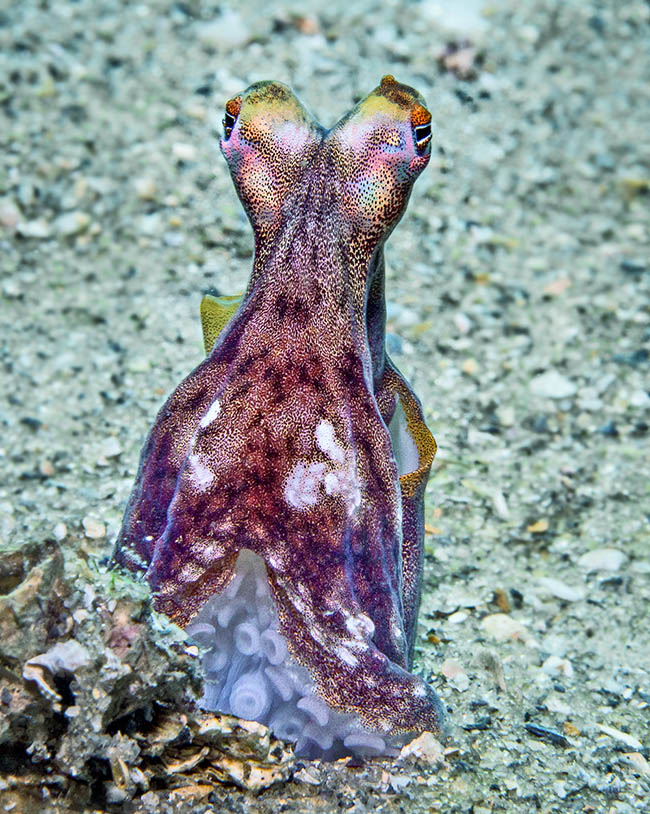
Here it is with another look. It has been defined the only alien present on Earth © Brian Cole
It belongs to the order of the Octopoda, containing 13 families with more than 200 species very different from each other, that have practically colonized the whole marine world, and to the family of the Octopodidae, cephalopods with no or rudimentary shell, sack-like body and eight arms attached to the body and fitted with suckers.
The genus Octopus comes from the union of two Greek words: “ὀκτώ” (okto), meaning eight, and “ποῦς” (poûs), foot. Therefore, it is an animal having eight feet, even if later they are called “arms”.
The specific name vulgaris, vulgar in Latin, is an epithet introduced by Linnaeus in the binomial nomenclature to nominate the most diffused and known species of a particular genus.
During the taxonomic study of these species, many have been the Authors who have given the name Octopus vulgaris to specimens later classified in a different manner.
This due to studies based exclusively on morphological data, as well as on the countless culinary and educational activities that listed all these species of pulps as Octopus vulgaris.
Common in systematic zoology is also the reverse problem: animals classified with the most different names that later will reveal as being members of the same species. Also the pulp is not exempt from this phenomenon, as shown by the innumerable synonyms associated with it.
Zoogeography
The Common octopus is present in the Mediterranean, and in the tropical, subtropical and temperate waters of the Atlantic, Indian and Pacific oceans.
Ecology-Habitat
Octopus vulgaris is an animal that never ventures below the 200 m of depth. Sensitive to cold as it is, not bearing temperatures under 17 °C, it performs seasonal migrations, though limited, moving towards the coast during the spring months when the surface of the water gets warmer.
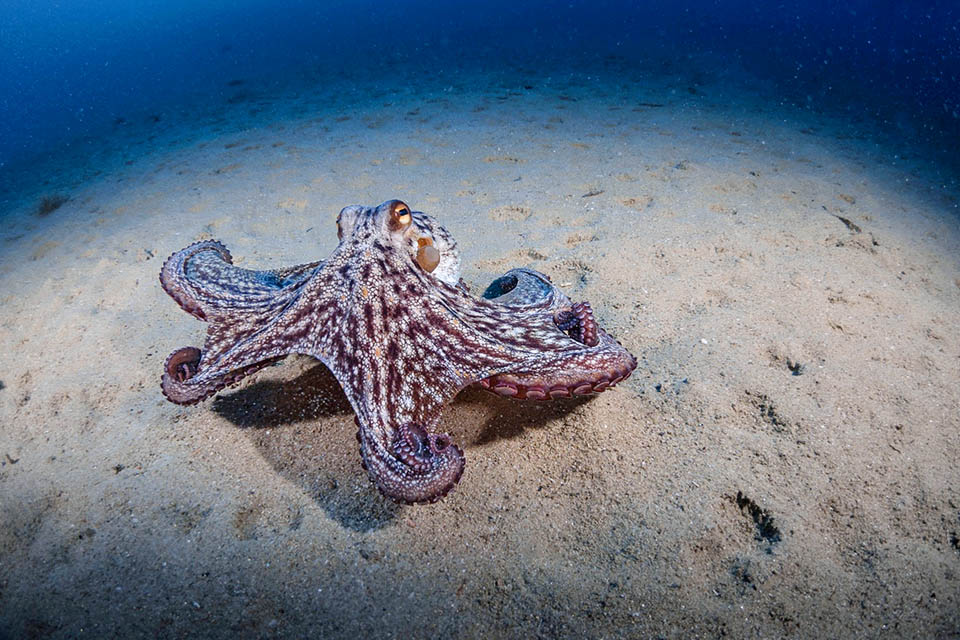
Here has again changed shape and seems to land from space. It has 3 hearts, and its intelligence form is very different from ours © Maurizio Pasi
It is a common thing to find it hidden among the rocks, the corals, or covered with sand during the hours of the day, to escape from the sight of the predators. It utilizes natural cracks, big abandoned shells and even, size permitting, bottles, to take shelter in a den. From this, with its arms, then often explores the surrounding environment looking for food.
The Common octopus has a very varied diet that includes crustaceans, small fishes, mollusks, gastropods, bivalves and polychaetas. In the tropical waters, it nourishes mainly the crabs of the genus Mithrax and the bivalves of the genera Lima and Ctenoides. In the European waters, the mollusks represent about 80% of its diet. Choice prey are Pilaria chione, Venus verrucosa and Haliotis tuberculata.
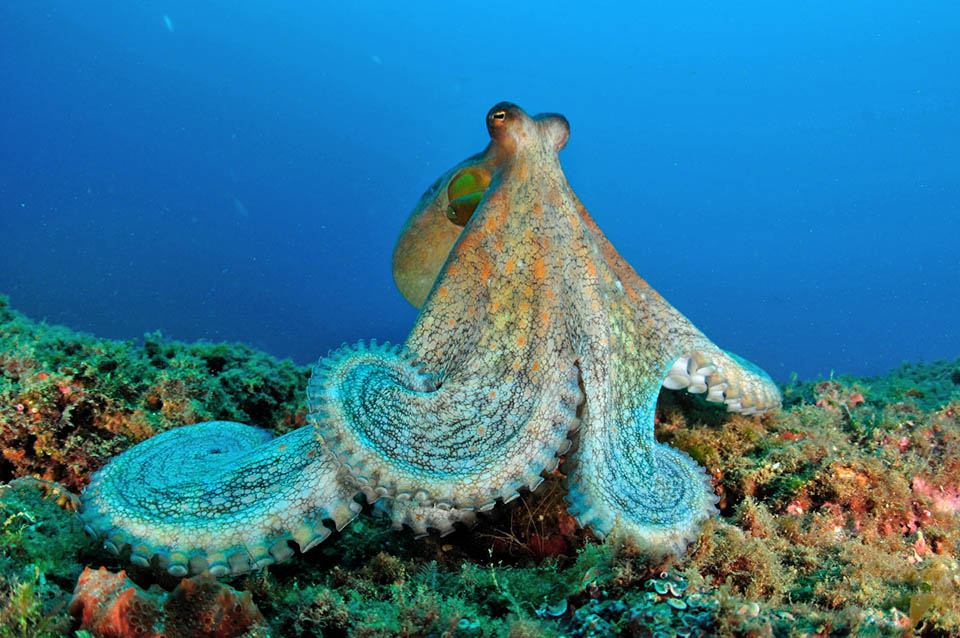
More, it has 18 chromatic components, 6 patterns, 14 postures and 4 locomotor components that can generate 12 body patterns © OCEANA- Carlos Minguell
Like many cephalopods, also the pulp has in its saliva particular cephalotoxins and neurotoxins used for immobilizing the prey after capture.
It feeds in a way similar to that of the spiders. It carries the prey into the den. If it’s a bivalve, it forces the opening of the shell by means of its arms, thanks to the suckers that can exert enough force to even cause harm on the human skin. It injects then with the bite of the jaws, in the soft body of the victim, digestive enzymes and then sucks up the tissues rendered in this way more assimilable leaving intact the harder residues.
Natural predators of Octopus vulgaris are the large fishes such as sharks, groupers, morays and conger eels.
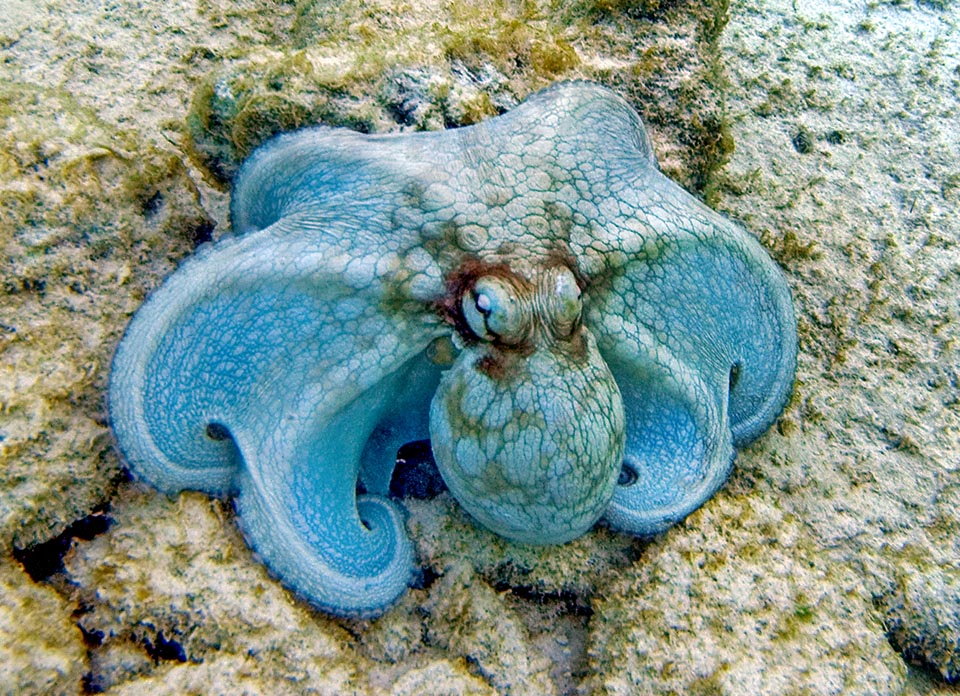
Nothing surprising to find it in this, one of its choice postures, coloured in blue. Not for camouflage but because it likes so © Paul Asman and Jill Lenoble
Some utilize special sensory organs, like the Ampullae of Lorenzini of the sharks capable to detect the magnetic fields emitted by the preys; others are the next-door neighbors, such as morays and congers, or go hunting, like the pulp, hidden among the rocks waiting for unaware victims to pass by.
None of these big enemies it has, however, it can vie with the man who, as it can be easily realized, is the main predator of this mollusk. It is enough to think that for human feeding are fished more than 100.000 tons of pulps per year, using longlines, hooks and creels.
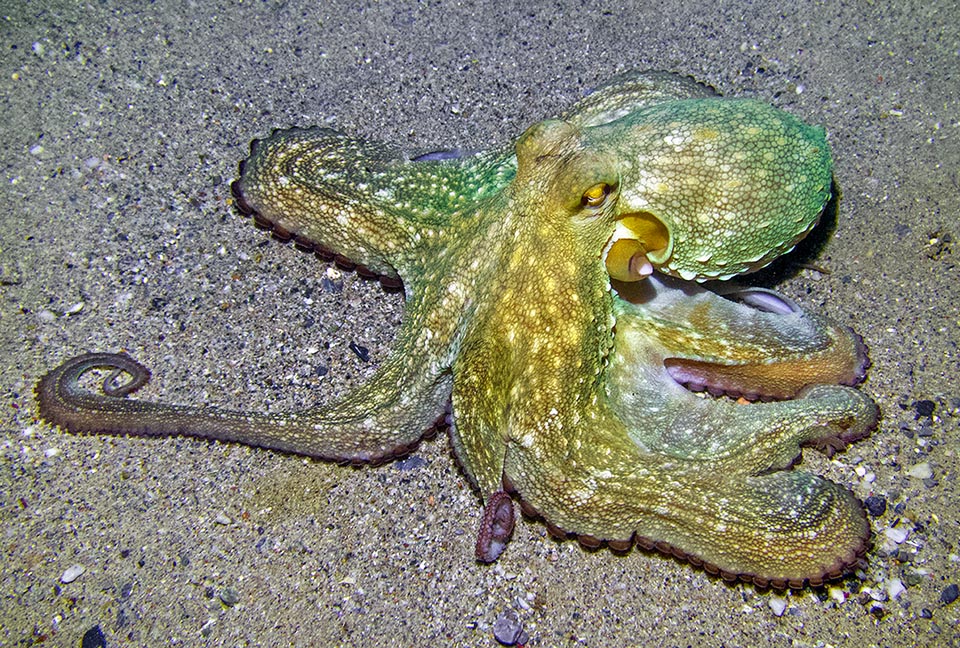
Here it is greenish, with a slimy and winding look. The tentacles are much more than an arm, seen that they contain more neurons than the brain © Michael Eisenbart
Morphophysiology
Octopus vulgaris is often mistaken for another cephalopod, the Musky octopus, (Eledone moschata), also often present in the Mediterranean cuisine. However, this is a similar animal never exceeding the length of 74 cm, with only one line of suckers on each arm.
Conversely, Octopus vulgaris, has two lines of suckers per arm and can reach a length of 3 m, with a weight of 10 kg, even if most of the catch in the Mediterranean zone measures about 3 kg and 1 m.

Exceptional sequence of the rapid change of look of an Octopus vulgaris in front of a diver. After three color versions, she reflects and concludes that for a good camouflage it would be better to add a very rough skin © Risa Inoue
The Common octopus has a rounded and compact body with only a trace of the shell typical of the mollusks that, over time, has thinned to such an extent to become flexible and assume, when swimming, a hydrodynamic shape.
The body has slimy and soft skin with several layers and types of cells: glandular, sensitive, pigmented, connectives and muscular.
The countless pigmented cells are controlled by the nervous system and maybe in this process are also involved the hormones.
They serve to modify the colour of the livery like the mythological Proteus, sea-god and god of waters, able to change shape and look at his pleasure.
The organs responsible for the chromatic variations include chromatophores, iridocytes and photophores.
The chromatophores are cells with granules pigmented of various colours (black, orange, red, yellow, blue), that by contracting or relaxing thanks to the peripheral muscles, create anew the environmental colours.
Conversely, the iridocytes do not contain pigments, but serve to improve the camouflage by refracting the light on the necessary wavelength when the iridocytes do contract.
Finally, the photophores are bioluminescent organs utilized in the darkness.
The surface of the body can be modified through the action of subcutaneous muscles creating variations in the webbing of the tegument that, along with those of the colour, of the shades and particular postures or movements, produce an incredible and varied body pattern.
Octopus vulgaris has 19 chromatic components, 6 webbings, 14 postures and 4 locomotory components that are able to generate 12 body patterns.
From the dorsal part of the body of the mollusk departs a skin folding, called mantle or pallium, that wraps completely the body and, ventrally, delimits an internal cavity, called pallial, where the gills for breathing are placed.
The mantle covers also another important muscular organ located ventrally, named siphon, very important for breathing, as it expels the water present in the pallial cavity after the oxygenation of the gills and for the “jet swimming” locomotion.
The compression and the expulsion with force of the water allow in fact the pulp to effect rapid movements.
They however do not represent its main means of locomotion, because the increase of the pressure inside the cavity of the mantle produced by the stored water, hinders the return of the venous blood through the three hearts the pulp disposes of, causing its temporary arrest.
In short, a sort of cardiac apnea.
The “jet swimming”, therefore, is utilized only for hunting or for escaping, often associated with the release of a particular black secretion, frequent in the cephalopods, formed by melanin.
The eight arms have up to 240 muscular suckers per arm, serving to catch and hold the preys, to move and to anchor on the bottoms.
In the male they have a further function linked to the reproduction and count millions of sophisticated tactile and chemical receptors for exploring the surrounding environment.
At the base of the head, between the arms, the buccal opening is characterized by a horny beak called rostrum with which the pulp breaks the solid shell of the seashells and the cuirasses of the crustaceans.
Located in a pocket of the buccal cavity stands the radula, a ribbon-like tongue, present in most of the mollusks, formed by a parallel series of teeth, that serves to rasp the food and to send it to the stomach.
The nervous system is very much evolute and considered to stand among the most specialized and complex of the whole phylum, and together with the Common cuttlefish (Sepia officinalis) has one of the highest mass-brain ratios in the world of the invertebrates.
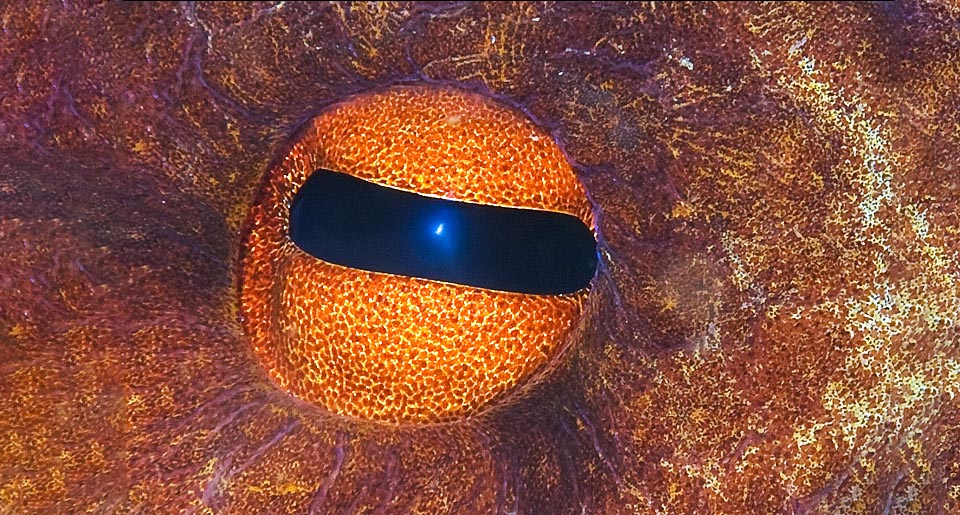
Octopus vulgaris is colourblind but eye perceives the colours polarization and can recreate the habitat ones thanks to chromatophores, iridocytes and photophores synergy © Sven De Vos
The brain is protected by a robust cartilaginous skull, located between the eyes, from where depart the peripheral ganglia of the arms. Two thirds of the nervous cells are in fact localized in the neuronal cords of the arms, proving once again how these body extensions are not just simple limbs used for moving, but complex gears of a mechanism moving in unison.
Also the other sensory organs are well developed, in particular the eyes that reach a notable evolutionary degree, representing one of the peculiar characteristics of the pulps as well as, generally, of the cephalopods.
Not only are they a useful hunting tool, but they perceive the light polarization to change the colour of the livery.
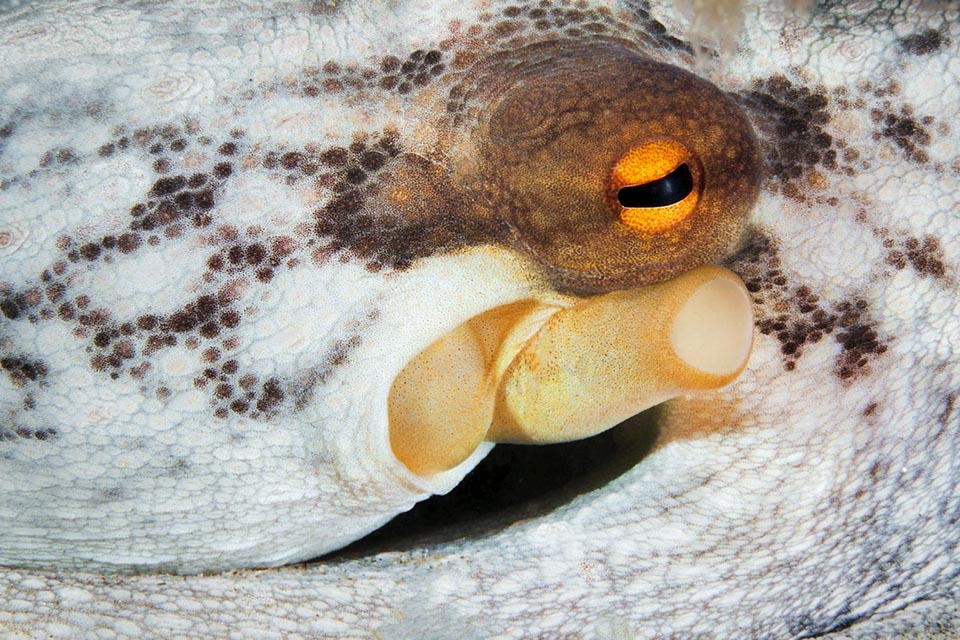
Here we can see also the siphon: an important muscular organ, placed ventrally, that serves to oxygenate the gills and to provide a fast locomotion © Maurizio Pasi
However, this does not mean that they are able to distinguish the colours as, in fact, they are colourblind, but those particular photoreceptors allow them to perfectly recreate forms and colours of the surrounding habitat.
The auditory system is another par excellence organ if these extraordinary animals: the hearing vesicles adhere to the cephalic cartilage and are compared in complexity to the acoustic labyrinth of the vertebrates. Although there are no particular internal structures necessary to amplify the sound, a sack-like organ containing a mineralized mass, called statocyst, seems to overcome this problem and is also a sensory receptor fundamental for balancing.
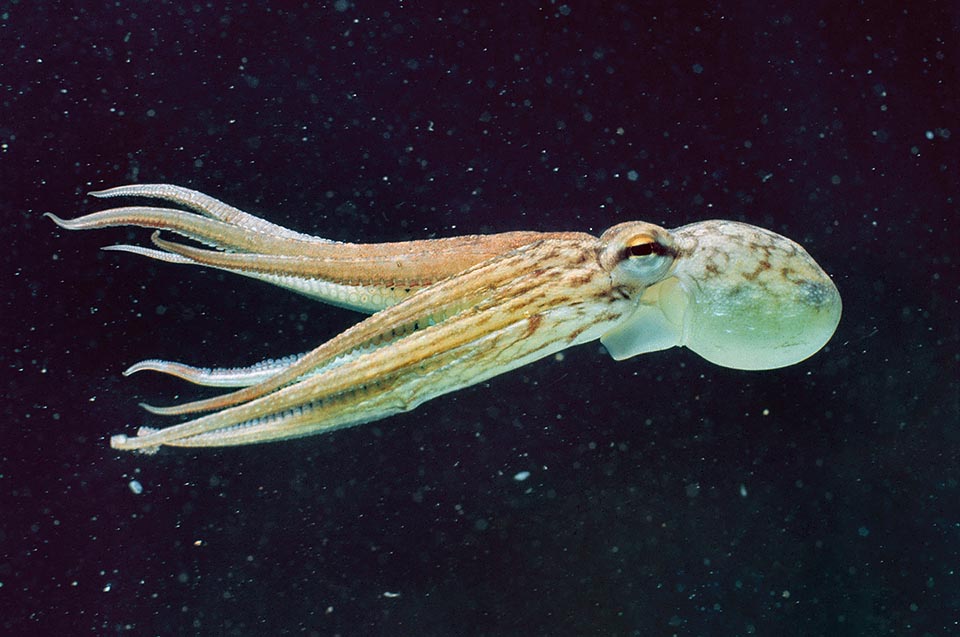
Here it is in jet swimming position, the fast swimming used to catch the prey or to escape a predator often associated with the emission of black ink. However, in this way the pressure done on the mantle compromises the circulation of the venous blood with a temporary cardiac arrests. In short, it is a kind of apnea © Giuseppe Mazza
Ethology-Reproductive Biology
Octopus vulgaris has a relatively short cycle of life lasting about one or two years even if, after some Authors, it varies depending on the geographical zone.
Also the reproductive season depends on this, so there are two peaks in the annual reproductions: March to May in the Mediterranean and in the adjacent Atlantic, and September-October in the tropical waters.
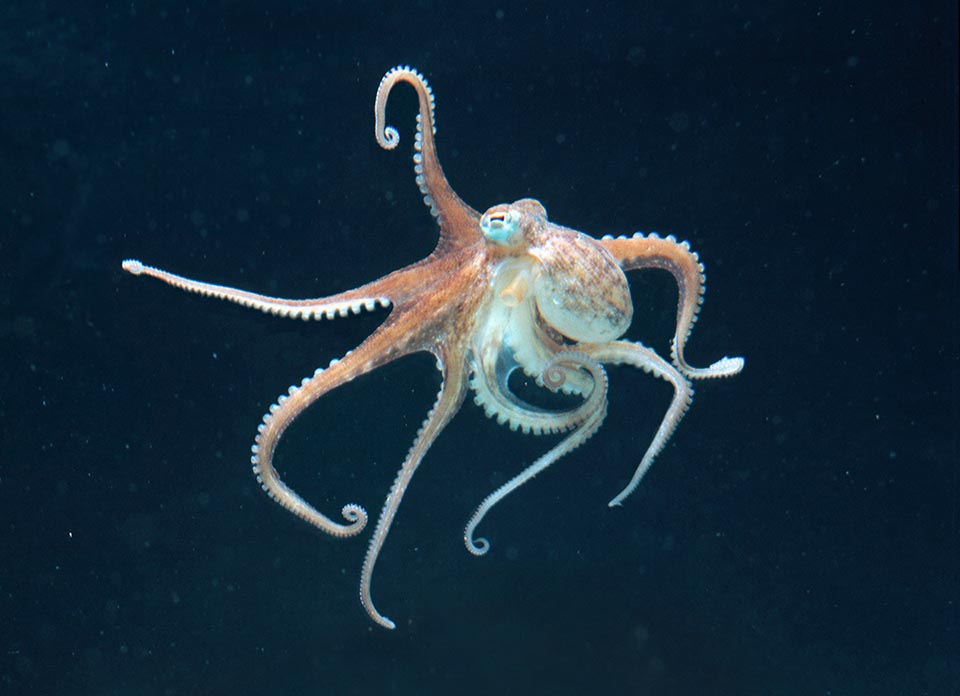
Here is why, if not in hurry, the Octopus vulgaris prefers this type of swimming much more relaxed and without consequences © Giuseppe Mazza
The males differ from the females due to the presence of special suckers of much bigger size than all others, placed at the base of the second and third pair of arms.
These suckers are utilized by the male during the courting as credentials to show the biggest females the reached sexual maturity and their good intentions.
Even if the pulp can change colour, this characteristic is not used while courting as happens in the Sepia officinalis, that performs in extraordinary dances. The exposition of the suckers is therefore the only form of courting of the male.
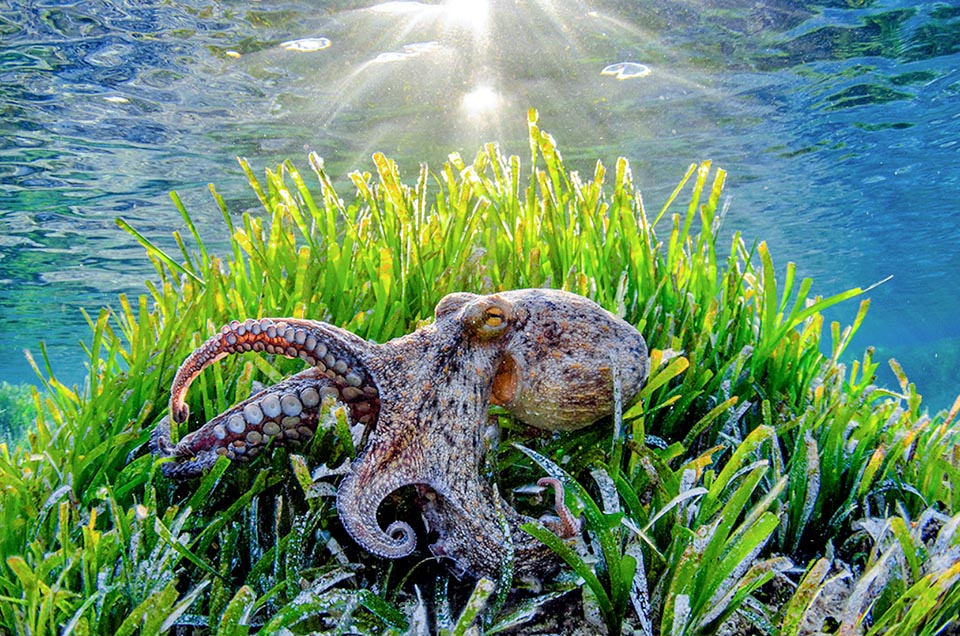
The Common octopus, here in a Mediterranean Posidonia prairie, is present in temperate, subtropical and tropical waters of Atlantic and Indo-Pacific © Xavier Mas Ferrà
Mating begins at distance with the male caressing the female extending its third right arm structurally modified, called hectocotylus, it tries to introduce inside the female mantle.
Initially this act is not accepted and actively hindered by the females, but after various attempts, it is accepted and the copula takes place in a particular manner.
The hectocotylus of the cephalopods varies from species to species and is one of the main taxonomic characters. It is formed by the ligula and the calamus, forming the final part, with ventral spermatic grooves. Inserted into the female mantle, orientates itself reaching the ovary where it releases its own gametes, injected by muscular contractions.
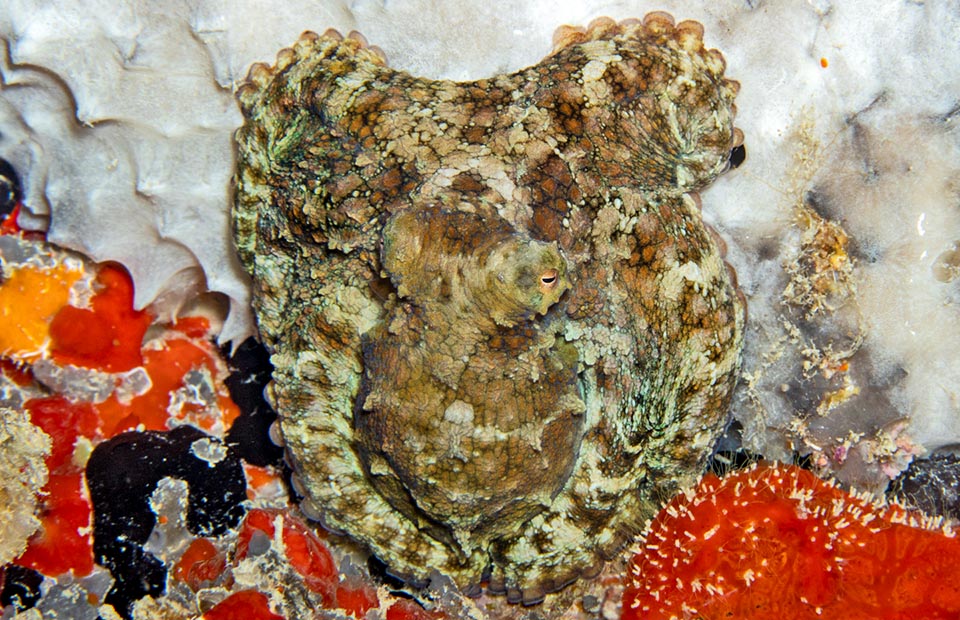
It can reach the 200 m of depth and here goes almost unnoticed, resting, in the Caribbean multicolored madreporic habitat © Allison & Carlos Estape
The female can spawn an unbelievable quantity of eggs, from 150.000 to 500.000, and for this reason Octopus vulgaris is rightly considered as the most prolific among the octopodes.
When ready to spawn, the female looks for a cleft between the rocks where to take shelter and where to stick the eggs by means of a gelatinous glue.
The eggs, minuscule, measure 1-2 mm and are hung individually or gathered by hundreds in numerous clusters.
Once the eggs are spawned, the female cares for them for about 6 weeks, eating truly little or not at all, in order not to leave traces of food residues that often attract the predators, with risks for itself as well as for the progeny.
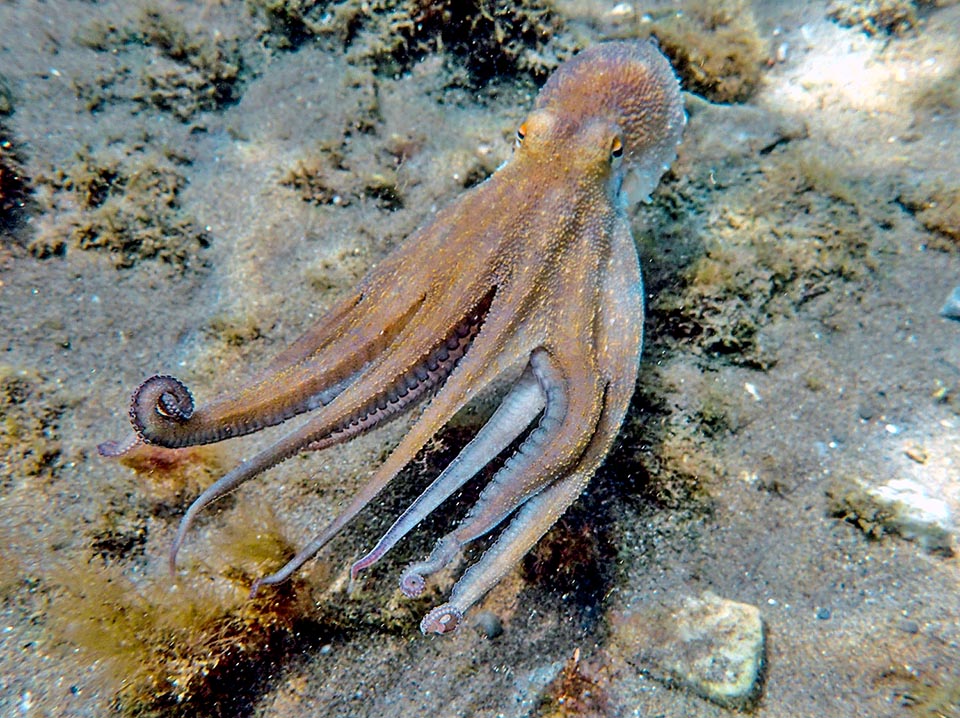
The Common octopus may reach, with extended tentacles, 3 m of length with 10 k of weight, but in the Mediterranean the catch is about 3 k and around 1 m of length © Fabián Bravo Guerrero
During all this time the mother cleans the eggs, defends them and oxygenates them until the hatch and when this occurs, it dies shortly after because of the enormous effort sustained.
Upon hatching, the newborns are pelagic paralarvae. Just 3 mm long, they might be considered as mini adults, but with only 3 little developed limbs, few suckers, simple chromatophores and transparent musculature.
Unlike the common larvae, they do not metamorphose while growing. They are planktonic but capable of active swimming and manifest immediately their predatory nature eating amphipods and ostracods.
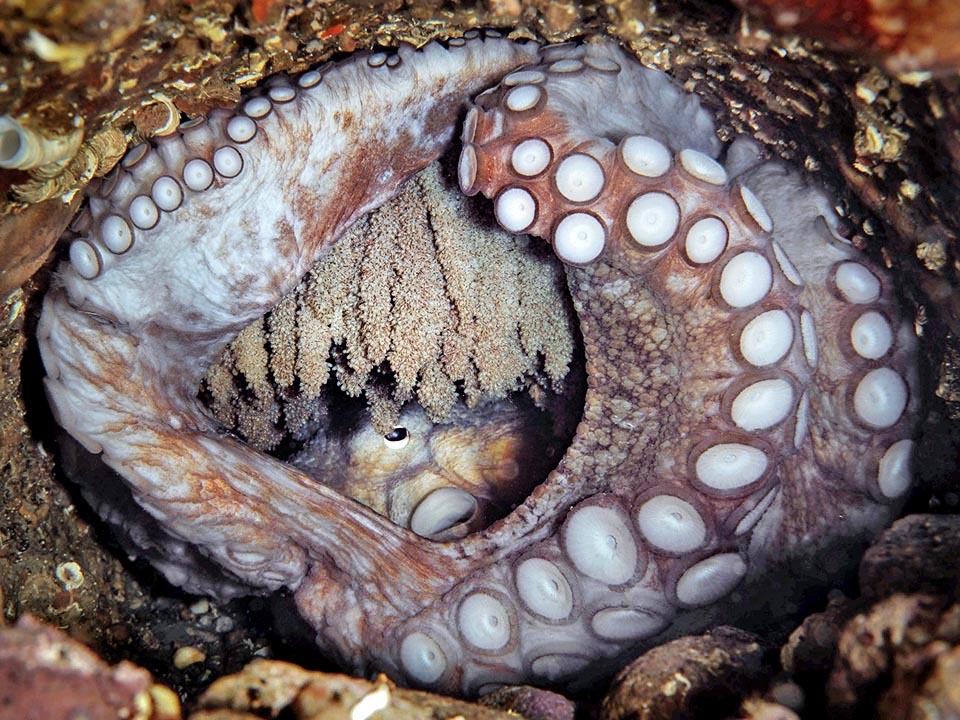
The females spawn 150.000-500.00 1-2 mm eggs, glued individually or in clusters in a ravine between the rocks, where it settles protecting them with the tentacles © Maurizio Pasi
About 65-75 days from hatching, they pass from a pelagic behaviour to a benthic one, with important morphological modifications that complete the number of arms and of suckers, with the development of the structural components of the skin.
During the colonization of the seabed the young pulps are still minute, with a weight of about 50-70 g and a breadth of a few centimetres.
Their diet changes completely, and now the nourish of mollusks, crabs, sea urchins and of fishes, almost doubling their size in a few months.
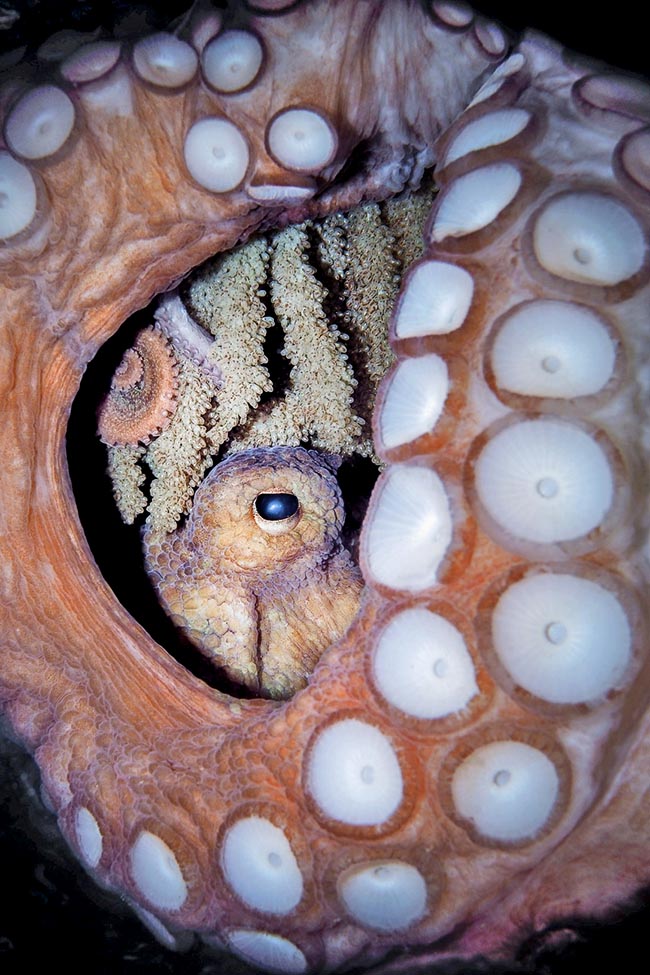
It surveys, cleans, and oxygenates them up to hatch for about 6 weeks even without nourishing for not leaving around food residues that might attract the predator’s attention. Then, exhausted, very often passes away © Maurizio Pasi
Males and females reach sexual maturity when at different sizes: the first ones can already mate when weighing about 300 g, whilst the females, to be able to spawn and protect the eggs, must wait to weigh 500-600 g.
The pulp has always been considered as an intelligent animal, smart, able to utilize tools to its own advantage, to imitate and to decide, after some, has even a keen sense of humour.
Their intelligence is presently an object of discussion, difficult to evaluate as quite different from ours. Some, perhaps not wrongly, have defined them as the true and unique aliens present in the planet Earth.
A pulp has half a billion neurons and, as already mentioned, has a high ratio between cerebral volume and body mass.
These factors, though approximate for establishing the intelligence, are however a sign of how much this animal invests in its cognitive abilities.
As if that were not enough for evaluating them correctly, also the structure of the brain is quite different from the one we have. Birds and even fishes have a brain that in some parts corresponds perfectly to the human one. In the pulps, it’s a completely different affair.
This leads to some considerations. The most fascinating is that of Peter Godfrey-Smith who wrote “if we are able to make an intelligent contact with the pulps (to understand and to make us understood by them), it is not because of a common history or some kinds of kinship, but because the evolution has built twice some minds.”
Since the comparison with the human brain is not very indicative, it has been tried to evaluate the cognitive power of the octopus starting from its behaviour.
Example of their high mental faculties is the experiment that has proven the learning of a task through the only observation of a conspecific previously trained to do a certain duty.
It had to choose a small ball of a certain colour, task followed by a reward.
If a not trained second pulp was placed close in the aquarium, separated by a glass, but able to see the conspecific at work, then isolated in another pool, it was capable of repeating the same behaviour in a quite shorter time that what could have done spontaneously.
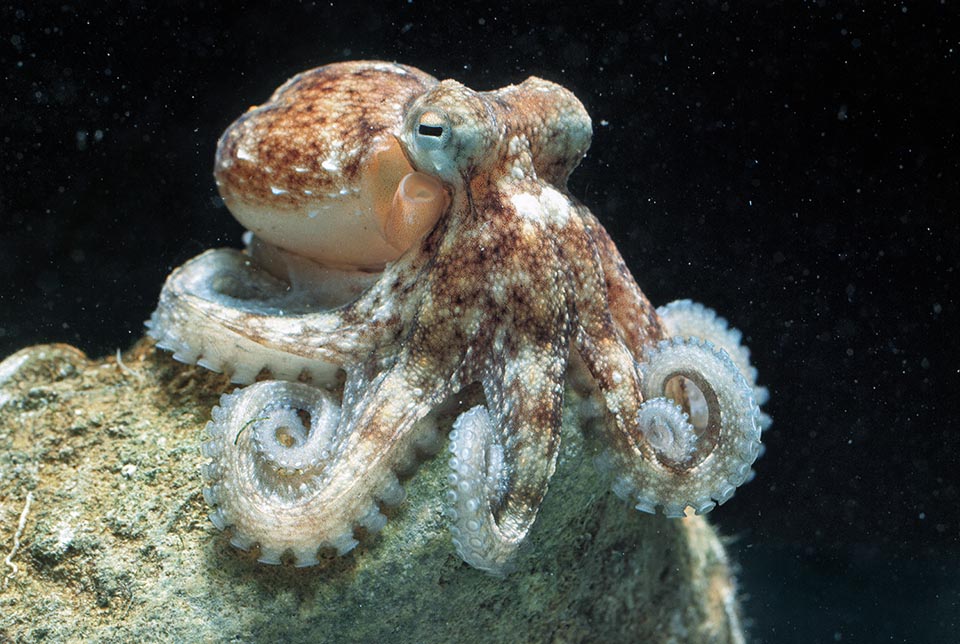
Newborns are 3 mm mini pulps called paralarvae. They have 3 arms only but are already able to predate amphipods and ostracods. When 65-75 days old all arms and suckers are present. From pelagic they become benthic and grow up fast, eating greedily mollusks, crabs, sea urchins and fishes. Here an almost 4 months old specimen © Giuseppe Mazza
This experiment has been one of the first demonstrations for the invertebrates in general, that has put these animals under a new light.
Another proof of their incredible cognitive capacity comes from a very recent (March 2021) experiment that has shown the pulp’s capacity in remembering painful experiences.
If, in fact, it is generally accepted that the vertebrates feel pain, this, until now, had never been documented in the invertebrates, raising new ethical reasons, and furnishing a new evolutionary origin for the experience of pain in the animal kingdom.
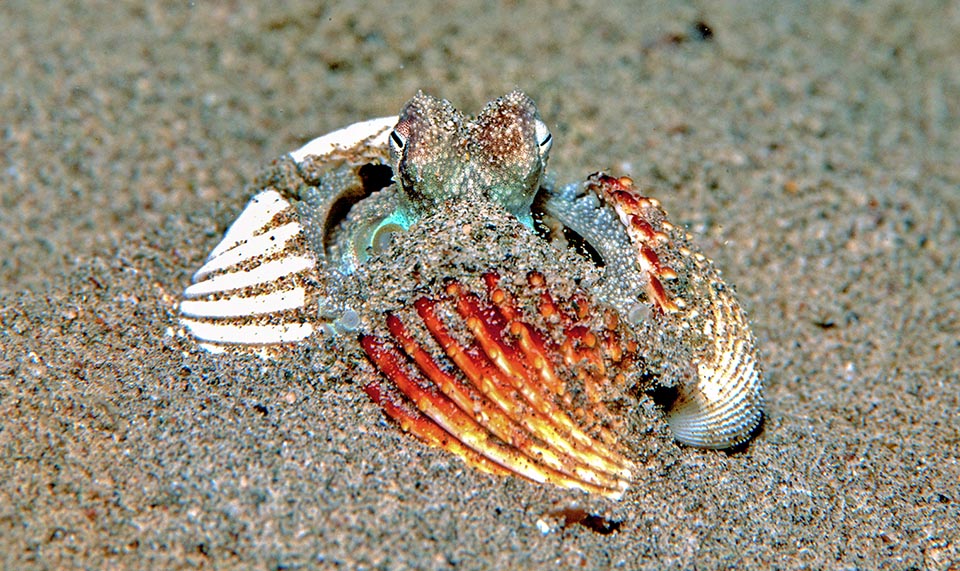
Even if young they display intelligence and cleverness hiding like the adults from the predators during the day hours. This one has built a house of shells © Hasan Yokeş
Even in modern times, this long-time studied animal does not stop in giving us surprises and in teaching us something, making us to think how the vision of the world, which we now take for sure and granted, is something more complex, always new continuously evolving.
Synonyms
Octopus bitentaculatus Risso, 1854; Octopus brevitentaculatus Blainville, 1826; Octopus cassiopea Gray, 1849; Octopus coerulescentes Fra Piero, 1895; Octopus heteropus Rafinesque, 1814; Octopus moschatus Rafinesque, 1814; Octopus maculatus Rafinesque, 1814; Octopus tuberculatus Targioni-Tozzetti, 1869; Sepia octopus Gmain, 1791; Sepia polypus Oken, 1815; Sepia rugosa Bosc, 1792
→ To appreciate the biodiversity within the MOLLUSCS please click here.
